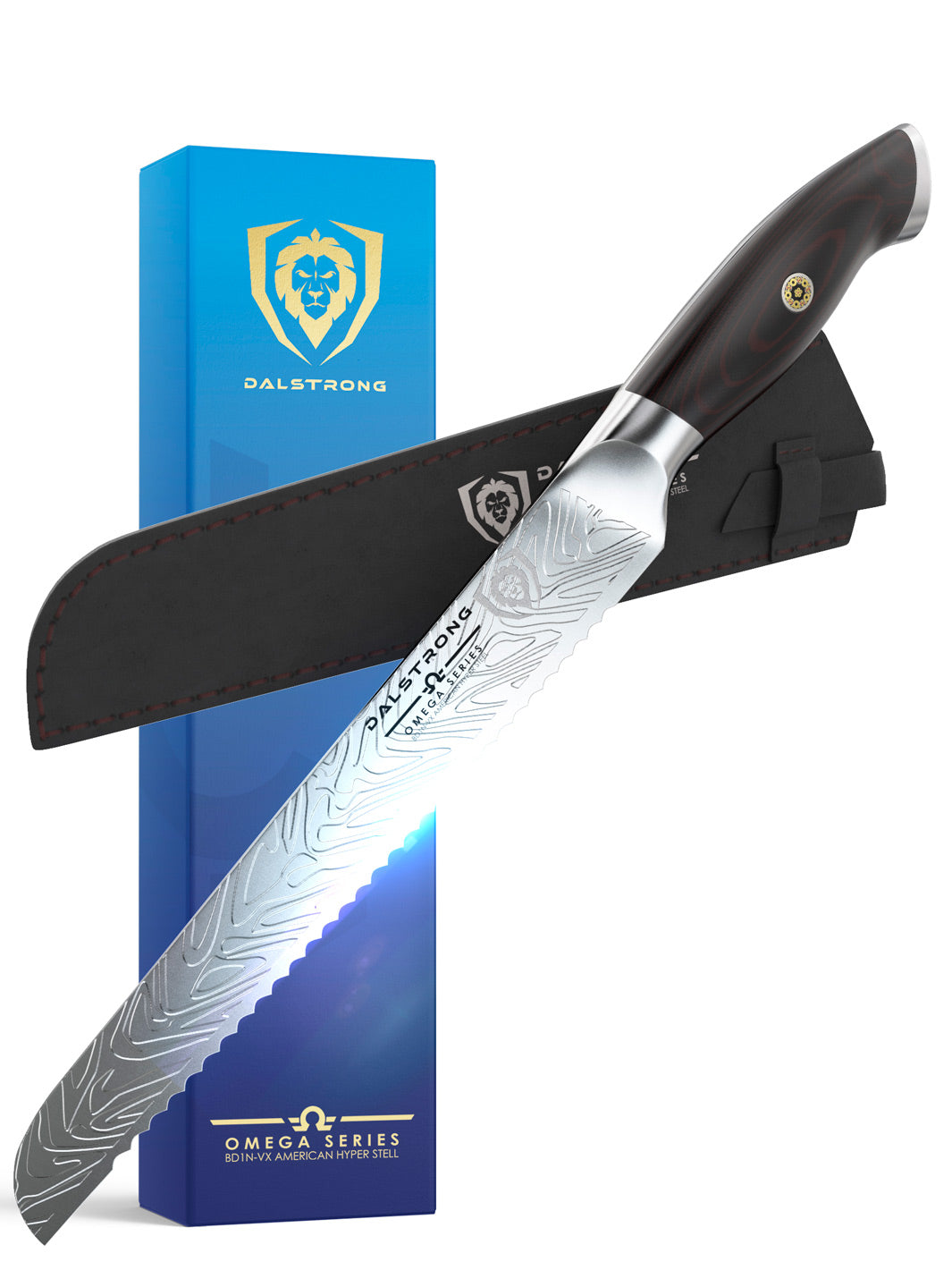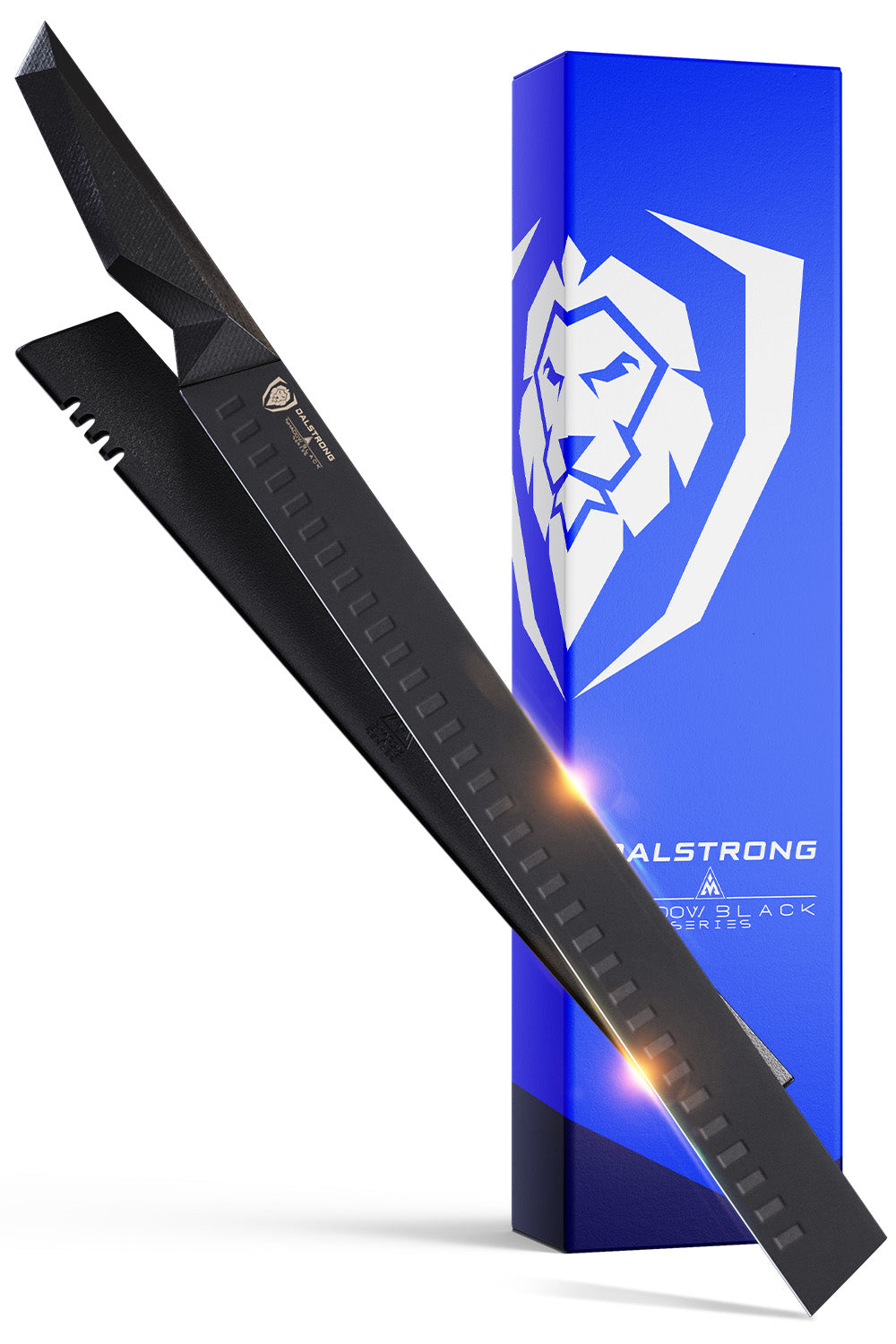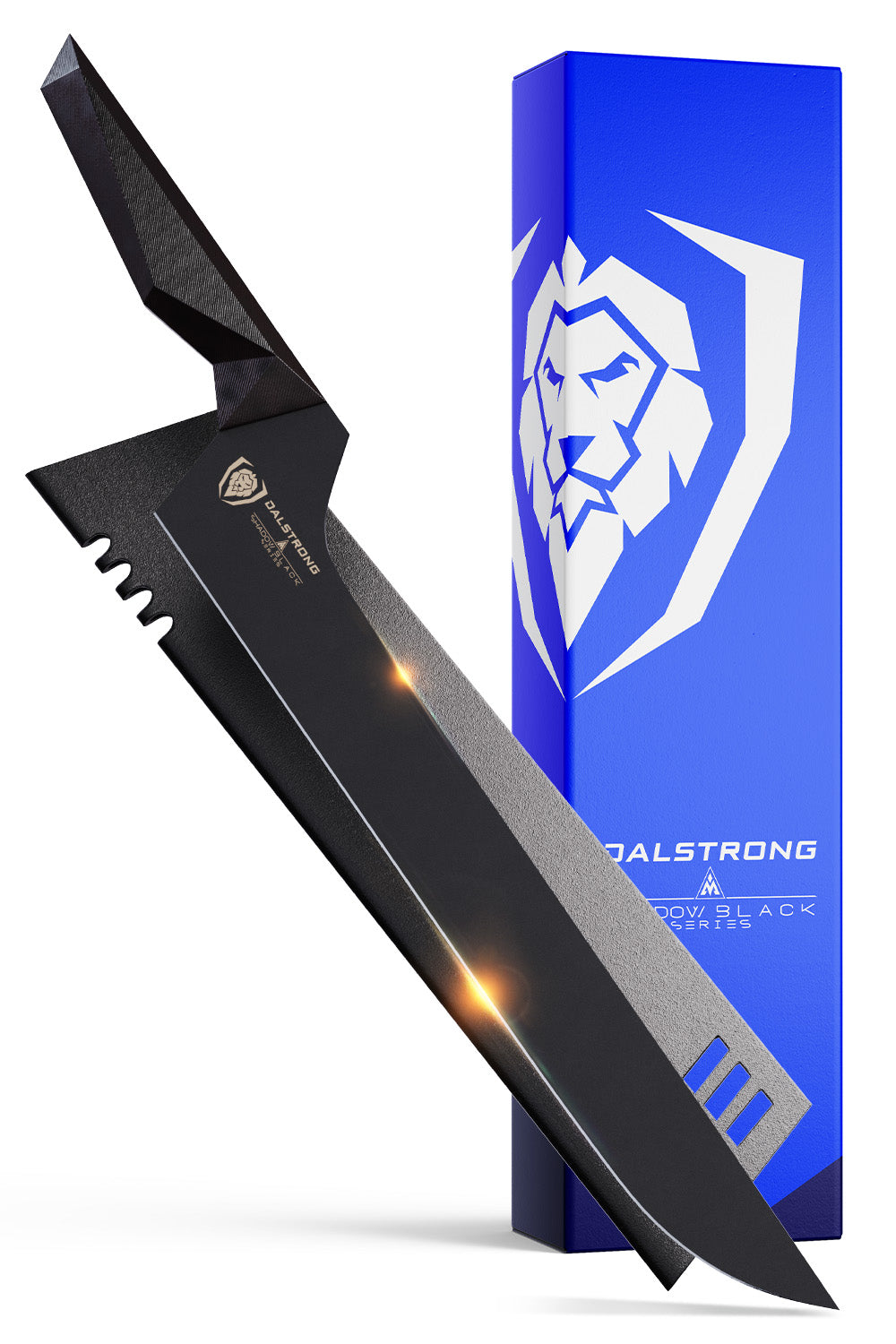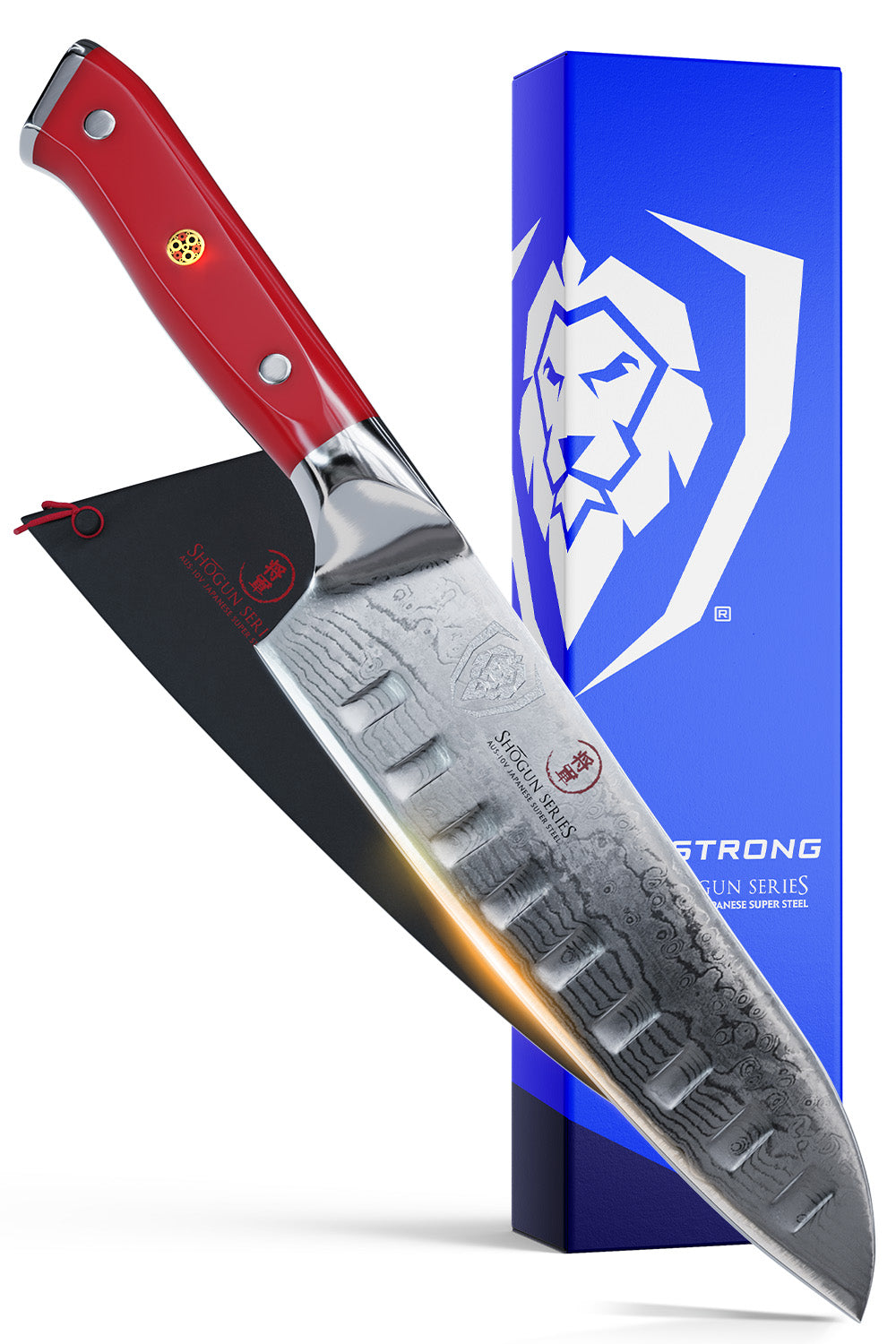 Dalstrong #1000 / #6000 Grit with Nagura Stone & Rust Eraser Premium Whetstone Kit
Dalstrong #1000 / #6000 Grit with Nagura Stone & Rust Eraser Premium Whetstone Kit
Knife sharpening is an essential skill for any home cook or professional chef. Dull knives can be dangerous and frustrating to use, and they can also affect the quality of your food. With the right knife sharpening kit and tools, you can keep your knives sharp and in top condition. In this blog, we’ll be discussing the various knife sharpening tools and kits available and their uses.
1. What Is a Knife Sharpening Kit & Its Uses
A knife sharpening kit is a collection of tools designed to help you sharpen your knives. There are many different types of knife sharpening kits available, from basic kits to professional models. A good knife sharpening kit should include at least one sharpening stone, a honing rod, and a leather strop. Now take a look at each of these tools in more detail.
Sharpening Stone
A sharpening stone is a rectangular block made of abrasive material. These stones come in various grits, from coarse to ultra-fine, and are used to sharpen and polish the edge of your knife. The most commonly used sharpening stones are made of either natural or synthetic materials such as silicon carbide or diamond.
Honing Rod
A honing rod, also known as sharpening steel, is a long, thin metal rod that is used to realign the edge of your knife. Honing rods do not actually sharpen your knife; instead, they help maintain the edge by straightening any bent or misaligned parts of the blade.
Now, let’s move toward understanding the history of knife sharpening and how it truly began.
2. History Of Knife Sharpening
The art of knife sharpening has been practiced for centuries, with humans using various methods to maintain the sharpness of their cutting tools. Over the years, the process of knife sharpening has evolved, with new technologies and materials being used to enhance the process. In this article, we will explore the history of knife sharpening and its evolution over time.
Early Methods of Knife Sharpening
Early humans used rudimentary tools made of flint and other stones to sharpen their knives. They would rub the blades of their knives against the rough surfaces of rocks, gradually sharpening them over time. The process was crude, but it was effective in maintaining the sharpness of the cutting edge.
As civilization advanced, so did the methods of knife sharpening. In ancient Egypt, for example, knives were sharpened using a simple honing rod made of ceramic or stone. This method involved rubbing the blade of the knife against the honing rod at a specific angle to achieve the desired sharpness.
Sharpening Stones
Sharpening stones were also used in ancient times, the earliest known samples dating back to the Neolithic period. These stones were made of various materials, including sandstone, quartz, and novaculite, and were used to sharpen knives, axes, and other cutting tools.
The use of sharpening stones became more widespread during the Middle Ages, with water-powered sharpening mills being used to grind the stones into the desired shape. These mills were powered by animals or water and allowed for a more consistent and efficient sharpening process.
Modern Sharpening Techniques
In the modern era, the art of knife sharpening has evolved significantly. While traditional methods such as sharpening stones and honing rods are still widely used, new technologies have been developed to enhance the process.
Electric knife sharpeners, for example, have become increasingly popular in recent years. These devices use motorized sharpening wheels to grind the blade of the knife, allowing for a quick and easy sharpening process.
Some electric sharpeners also incorporate angle guides to ensure a consistent sharpening angle. They are frequently used by home cooks and professional chefs alike and are known for their precision and ease of use.
Another recent development in the field of knife sharpening is the diamond sharpening system. Diamond sharpeners use abrasive diamond particles to sharpen the blade of the knife, resulting in a very sharp edge. These systems are often used to sharpen serrated knives, as they can easily sharpen the individual teeth of the serrated edge.
So, folks, it would be an understatement to say that the art of knife sharpening comes a long way since before time of using stones to maintain the sharpness of cutting tools. With new technologies and materials, the sharpening process has become more precise and efficient than ever before.
Keep reading to know how Dalstrong’s knife sharpening tools and knife maintenance service can do the same for you in the kitchen with your beloved knives.
Whether using traditional methods such as sharpening stones and honing rods or modern techniques such as electric sharpeners and diamond sharpening systems, the goal remains the same: to maintain a sharp and effective cutting edge.
What Are Some Popular Knife Sharpening Tools Used?
Sharpening Stones
Sharpening stones have come a long way since the early days of using crude rocks. Today, sharpening stones are made from a variety of materials, each with its unique properties and advantages.
Whetstones are perhaps the most common type of sharpening stone. These stones are made of natural or synthetic materials, such as ceramic or silicon carbide, and are designed to be used with water or oil as a lubricant. They come in different grits, with higher grits producing a finer edge.
Diamond stones
Diamond stones use abrasive diamond particles to sharpen the blade of the knife. These stones are known for their ability to remove metal quickly and efficiently, resulting in a very sharp edge. They are often used in professional settings, such as in butcher shops and restaurants.
Ceramic stones are another kind of sharpening stone. They are made of a hard ceramic material and are known for their ability to produce a very sharp edge. Ceramic stones are often used to sharpen knives with very hard steel, such as Japanese-style knives.
Other Accessories and Techniques
In addition to sharpening stones, various accessories, and techniques have been developed to enhance the sharpening process.
Angle guides, for example, are often used to ensure a consistent sharpening angle. These guides are placed on the blade of the knife and are used as a reference point for maintaining the proper angle while sharpening.
Pull-through sharpeners have become increasingly popular in recent years. These sharpeners use a set of abrasive wheels to sharpen the blade of the knife. They are often used by home cooks as a quick and easy way to sharpen knives but are not recommended for professional use, as they can remove too much metal from the blade.
So, with the evolution of knife sharpening from the early days of using rocks to sharpening stones, electric sharpeners, and diamond sharpeners, the goal remains the same for home cooks and seasoned chefs – to maintain a sharp and effective cutting edge.
With modern tools and techniques, it has never been easier to keep knives sharp and in top working condition.
3. Popular Tools For Knife Sharpening
 #400 / #1000 Grit Premium Whetstone Set Dalstrong
#400 / #1000 Grit Premium Whetstone Set Dalstrong
When it comes to sharpening knives, there are many tools and accessories to choose from. Here are some of the most desired tools for knife sharpening, along with their advantages and potential drawbacks:
Sharpening Stones
Sharpening stones are one of the oldest and most traditional tools for knife sharpening. They are obtainable in many materials such as whetstone, diamond stones, ceramic stones, etc.
These stones come in different grits, and the user needs to move the knife's blade against the stone to sharpen it. Sharpening stones are known for producing a very sharp edge, and they are relatively inexpensive compared to other sharpening tools. However, they require some practice and skill to use effectively.
Electric Knife Sharpeners
Electric knife sharpeners are a quick and easy way to sharpen knives, especially for home cooks. They use motor-driven abrasive wheels to sharpen the knife's blade, and some models have different stages for sharpening and honing.
Electric sharpeners are relatively easy to use, and they can sharpen knives quickly. However, they can be expensive and harsh on the blade of a majority of knives, and they tend to remove more metal from the blade than other sharpening tools.
What Are Guided Sharpeners?
Guided sharpeners are designed to help maintain a consistent angle while sharpening knives. They use a guide to keep the blade at a specific angle while sharpening. Guided sharpeners come in different forms, such as sharpening rods, sharpening systems, and pocket sharpeners.
They are relatively easy to use and can help beginners maintain a consistent angle while sharpening. Although, they may not be as functional as other sharpening tools in producing a very sharp edge.
A Crash Course On Honing Rods
Honing Rods
These rods are used to maintain the sharpness of a knife between sharpenings. They are made of steel or ceramic and are used to realign the edge of the blade. Honing rods are relatively easy to use and can help keep a knife sharp. However, they are not designed to sharpen dull knives and may not be as effective as other sharpening tools.
So, while there are many different tools available for knife sharpening, each with its advantages and disadvantages, sharpening stones are the safest and most durable choice.
Sharpening stones are a traditional and reliable choice, while electric sharpeners are quick but abrasive. Guided sharpeners can be helpful for home cooks who are just kicking off their culinary journey, and honing rods can help maintain a knife's edge.
4. How To Use a Knife Sharpening Kit
 #3000 / #8000 Grit Premium Whetstone Set Dalstrong
#3000 / #8000 Grit Premium Whetstone Set Dalstrong
If you want to maintain your knives sharp, a knife sharpening kit can be a useful tool to have on hand. However, if you're not familiar with how to use a sharpening kit, it can be a little intimidating.
-
Gather Your Materials. Before you get started, you'll need to make sure you have all the necessary materials. A knife sharpening kit typically includes a sharpening stone or series of stones, as well as honing oil or water to lubricate the stone. Some kits may also include angle guides, honing rods, or other accessories. Always read the instructions that comes with the kit carefully to ensure you have everything you need.
-
Choose the Right Stone. The first step in using a sharpening kit is to choose the right stone. Different stones have different grits or levels of coarseness, which are suitable for different types of knives and levels of dullness. Coarse grit stones are best for very dull or damaged knives, while fine grit stones are better for regular maintenance or touch-ups. If you're not sure which stone to use, start with a medium-grit stone and work your way up or down as needed.
-
Lubricate the Stone. Once you've chosen your stone, you'll need to lubricate it with honing oil or water. This helps keep the stone from clogging and makes it easier to move the blade across the surface. If you're using oil, apply a few drops to the stone and spread it evenly with your fingers or a cloth. If you're using water, soak the stone in water for a few minutes before use.
-
Set the Angle. To have the best outcome, it's important to maintain a consistent angle while sharpening. Many knife sharpening kits come with angle guides to help you maintain the correct angle. These guides attach to the spine of the knife and help you keep the blade at the right angle as you move it across the stone. If your kit doesn't come with an angle guide, you can try using a small piece of cardboard or paper to help maintain the angle.
-
Sharpen the Knife. With the stone lubricated and the angle set, you're ready to start sharpening the knife. Hold the knife with the blade facing away from you and the edge resting against the stone. Using light pressure, move the blade across the stone, following the angle guide or cardboard template as you go. Repeat this motion several times, then flip the blade over and repeat on the other side.
-
Hone the Blade. Once you've finished sharpening the knife on the stone, it's time to hone the blade. Honing helps realign the edge of the blade and remove any small burrs or imperfections. To hone the blade, use a honing rod or similar tool. Hold the rod at the same angle as the sharpening stone and run the blade down the rod several times on each side.
-
Test the Blade. Once you've finished honing the blade, it's time to test it to see if it's sharp. Slicing through a paper or cutting through a tomato to see how easily the knife cuts. If the blade still feels dull, repeat the sharpening and honing process until you achieve the desired level of sharpness.
In conclusion, using a knife sharpening kit is a simple process that can help you keep your knives sharp and in good condition. With the right equipment and a bit practice, you can sharpen your knives like a pro and enjoy the benefits of a sharp, efficient
Read about honing vs sharpening: what is the difference?, here.
5. Dalstrong’s Knife Sharpening Tools For You
1. Dalstrong #1000 / #6000 Grit with Nagura Stone & Rust Eraser
The Dalstrong Premium Whetstone Set is made with high-quality materials, which ensures long-lasting performance and durability. The set includes two whetstones of different grits, allowing for precision sharpening and polishing of different types of knives and other bladed tools.
PROS:
- The set can be used to sharpen both German and Japanese-style knives, as well as scissors and other bladed tools.
- The included Nagura flattening stone helps to maintain the surface of the sharpening stones, prolonging their lifespan.
- The handcrafted Acacia wood base adds to the set's overall aesthetic appeal and helps achieve a smooth surface for easy sharpening and storage.
CONS:
- The size may make them difficult to store in smaller kitchen spaces or travel with.
- The larger size of the stones may make it difficult to use on smaller blades or narrow points.
2. #3000 / #8000 Grit Premium Whetstone Set Dalstrong
The Dalstrong Whetstone set is an ultimate sharpening solution for those who want to maintain and sharpen their knives. It includes two top-grade corundum whetstones with grits of #3000 and #8000, providing precision sharpening and a mirror polish finish.
PROS:
- Larger and thicker stones provide increased surface area for better performance.
- Comes with two individual whetstones, offering precision sharpening for dull or damaged blades.
- The included #3000 grit stone is an all-purpose stone, while the #8000 grit stone is ideal for creating a mirror polish and sharp edge.
CONS:
- Need some skill and practice to use successfully.
- Beginners may need to invest time and effort to nail the knife sharpening process.
3. #1000 / #6000 Grit Combo with Oak Storage Box Portable Whetstone Kit Dalstrong
This portable whetstone kit is a convenient and portable solution for maintaining the edge of your knives and tools while on the go. The set includes a double-sided whetstone with premium Corundum construction, featuring #1000 grit for sharpening and #6000 grit for polishing.
PROS:
- Made of premium top-grade corundum, ensuring quality and effectiveness.
- Comes in a stylish oak wood storage box with an engraved Dalstrong logo.
- Includes a non-slip silicone mat for added safety during sharpening.
- Dedicated after-service care is available for additional support.
CONS:
- Limited to only two grits.
- May not be ideal for larger knives or tools that require a larger sharpening surface.
4. #400 / #1000 Grit Premium Whetstone Set Dalstrong
This whetstone set is designed to help you maintain and sharpen your knives and tools to ensure they remain in peak performance. This set is ideal for sharpening both German and Japanese-style knives, scissors, and other bladed tools.
PROS:
- Protects and maintains your blades.
- Comes with a detailed instruction manual and a step-by-step whetstone sharpening guide.
- Dalstrong's renowned packaging makes it a perfect gift idea.
CONS:
- The set does not include a higher grit finishing stone, which may be necessary for achieving a mirror-polish edge on some knives.
- If you are not assured in your sharpening abilities, it may take some time to get the hang of using these stones.
6. Frequently Asked Questions
What is the best thing to sharpen a knife with?
A sharpening stone or whetstone is the best tool to sharpen a knife.
Are pull through knife sharpeners any good?
These knife sharpeners aren’t recommended as they may remove more metal from the blade and can result in an uneven edge.
Is a whetstone better than a sharpener?
Many professional chefs and knife enthusiasts prefer using a whetstone for its versatility and ability to create a razor-sharp edge.
How will I know if my blade is 15 or 20 degree?
You can usually find the information about the angle in the product information or by contacting the manufacturer.










 Dalstrong
Dalstrong 



